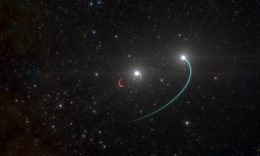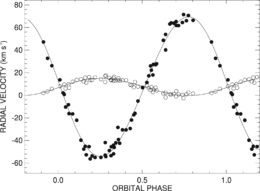A few months ago, scientists announced the indirect detection of the nearest black hole to Earth. But another team is now suggesting a different explanation for this stellar puzzle.
HR 6819: History of a Mystery
From the earliest spectra of HR 6819, scientists identified this source as a bright, early-type Be star — a hot star with emission lines, likely due to the accretion of a circumstellar disk of material. As our ability to resolve detail in stellar spectra has advanced, however, a more complicated picture has emerged.
Studies in the 1980s revealed unexpected narrow absorption lines in HR 6819’s spectra, and a 2003 study showed that these lines were moving over time. This indicated that, though we couldn’t optically resolve them, there were two components of HR 6819: a Be star exhibiting no obvious motion, and a B3 III star on a 40-day orbit.

Artist’s impression of HR 6819 as a triple system. Here, an inner binary consists of a star (blue orbit) and a black hole (red orbit). A third star (blue) circles the inner pair on a wider orbit. [ESO/L. Calçada]
Based on the B3 III star’s orbit, the black hole would need to weigh more than 4 solar masses — and at just 1,120 light-years distance from Earth, this object would be the closest black hole known. But could there be another explanation for HR 6819’s spectra?
Just the Two of Us
In a new study, Georgia State University scientists Douglas Gies and Luqian Wang argue that HR 6819 isn’t a triple system after all. Instead, it’s a simple binary, consisting only of the two known components: the Be star, and the B3 III star.
If HR 6819 is merely a binary, then the Be star should show reflex orbital motion with the same period of 40 days — but this motion could be small, and hard to detect in the complex spectra of the system.

Observed and fitted radial velocity curves for the B3 III star (filled circles) and the disk surrounding the Be star (open circles). The evident orbital motion suggests the two stars comprise a binary system. [Gies & Wang 2020]
An Unequal Pair
So why is the Be star’s orbital motion so much smaller than that of its B3 III companion? If the Be star has a typical mass of ~6 solar masses, the companion must be only a fraction of a solar mass in size. It may be in a stage of evolution where it’s already donated a significant amount of mass to its companion, and now only the stripped-down remnant remains.
Is the case closed on HR 6819? Far from it! This system continues to challenge our assumptions and gives us the opportunity to practice the process of science as we work to explain our observations.
Citation
“The Hα Emission Line Variations of HR 6819,” Douglas R. Gies and Luqian Wang 2020 ApJL 898 L44. doi:10.3847/2041-8213/aba51c


9 Comments
Pingback: From AAS NOVA: “Casting Doubt on a Nearby Black Hole” | sciencesprings
Pingback: Het bestaan van het meest nabije zwarte gat (HR 6819) in twijfel getrokken
Pingback: Wątpliwości związane z pobliską czarną dziurą – PTMA Kraków
Pingback: Wątpliwości związane z pobliską czarną dziurą – Astronomia Śląska
Pingback: Casting Doubt on a Nearby Black Hole – Sky & Telescope – AstroBrief
Pingback: Casting Doubt on a Nearby Black Hole – Sky & Telescope - Fashion Blog
Pingback: Dudas sobre el agujero negro más cercano a la Tierra | Viva Danlí
Pingback: அருகிலுள்ள கருப்பு துளை மீது சந்தேகம் - ஸ்கை & தொலைநோக்கி - TamilNewsPapper
Pingback: Astronomy Something stretches a giant star oval in the constellation of the Unicorn – scientists say it’s a special, small black hole – Pledge Times